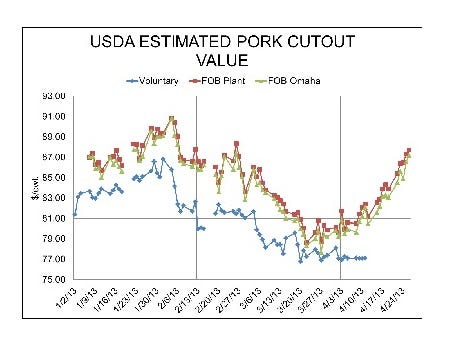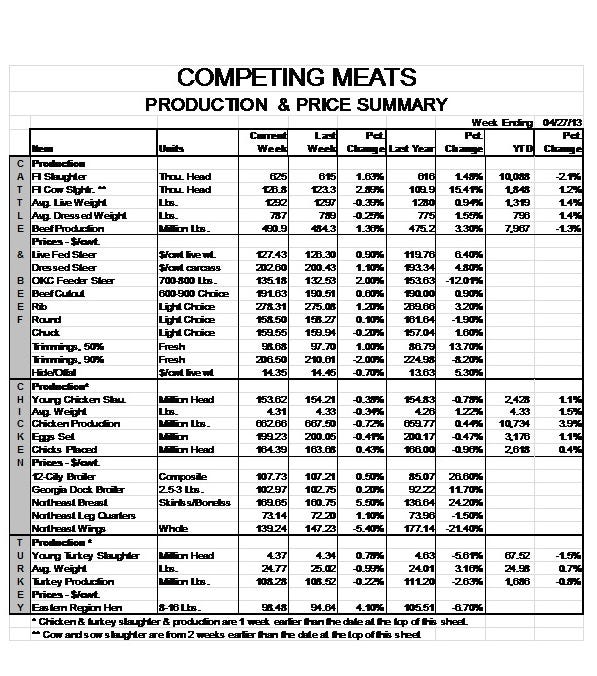New Mandatory Reporting is Good, but not without Pain
April 29, 2013

The “big change” has been made and the pork industry is now trying to figure out just how to use it.
The newly-minted mandatory reporting data for wholesale cuts will take some getting used to. Some are saying the change is huge; others think it is something that will just take time. To some degree, both are correct.
Here’s what we know and don’t know about this new data reporting system:
The complete changeover from voluntary to mandatory has occurred quicker than anyone wanted. Most everyone knew the reported prices would be different. That’s why producers, packers and processors pushed for a 12-month overlap of the two systems so the relationships could be observed and worked into pricing formulas. Over half of all hogs are formulated off either the cash hog price (which is itself driven primarily by the cutout value) or directly from the cutout value. Most believe that an even higher percentage of some pork cuts are formulated off reported wholesale prices. Knowing how those base prices might change was important to everyone.
The 12-month overlap, however, required some major resources for USDA, resources everyone knew would be hard to come by. USDA said they would go six months provided the data remained available. The plan was to publish daily data on a one-week delay to leave an incentive to continue voluntary reporting. That was a good plan until the actual data appeared in January.
Like what you're reading? Subscribe to the National Hog Farmer Weekly Preview newsletter and get the latest news delivered right to your inbox every Monday!
To everyone’s surprise, the average wholesale cut prices under the mandatory system were higher than the voluntary-reported prices. The working assumption had always been that pricing formulas created a strong incentive for packers to report the highest prices received, since that high price would set the value for so much more product. By including all sales in the mandatory system, the theory was that they would bring all of the lower prices into the weighted average calculations, pulling the averages – thus the cutout value – lower. Pretty logical, right? Wrong.
The mandatory-reported prices for virtually every cut have been higher than before and drove a large differential between the cutout based on voluntary data and the cutout based on mandatory data (Figure 1). It also caused a number of high-level USDA people to be very uncomfortable publishing lower prices in real time and higher prices lagged one week. Their concerns became public and that, in my opinion, doomed the voluntary system. Voluntary-reported volume began to deteriorate quickly and the system was discontinued on April 11.
Figure 1:

Don’t get me wrong, the new system is much better. It captures far more trade volume (Figure 2). It includes far more products, including value-added products and products shipped to Mexico and Canada. It includes less-than-truckload shipments. It actually includes the products that are traded (e.g., derind bellies), in addition to those that are sort of “manufactured for price reporting (e.g., skin-on bellies).
Figure 2:

Change is Painful
Change, as it relates to information, is very painful. New information sometimes has no context. A perfect example is the new weekly pork export data. Was the 51,200 metric tons exported the week ending April 18 good or bad? About all we know is that it was more than the 31,000 metric tons shipped the week before. Other than that, who knows? We’ve never had the data before.
The same is true of these prices. There is no doubt that the rising cutout values of the past two weeks are good for everyone, but are they the same relative to hog values and the old cutout values? Should they be?
I think the answer to both of those questions is “no.” These are different numbers. They are based on a broader set of cuts – a good thing, but a challenge. They are the result of a new set of cut yields, which is a good thing since the new yields reflect the way things are now, not as they were in 2006 when the last yields were updated. Still, they are a challenge. The new values should be different in absolute terms and are quite possibly different relative to the value of a hog.
The challenge is to find a way to relate the new data in a fair and equitable manner. That’s no small job and it won’t be done quickly. Packers and producers must sort this out. The truth is that each of them likely deserves part of the differential – packers for adding value to raw pork cuts and producers for delivering carcasses that contain more of those raw pork cuts.
It will all come out in the wash, but the washing process will not be easy or pretty.


You might also like:
Does H7N9 Chinese Flu Pose a Threat for Pigs?
Teens Who Eat a Lean Pork Breakfast Consume Less Empty Calories
You May Also Like



